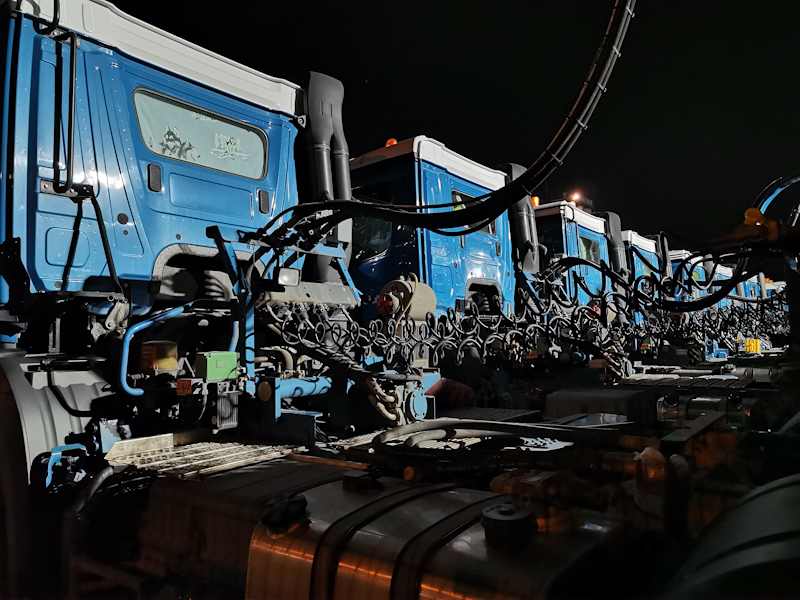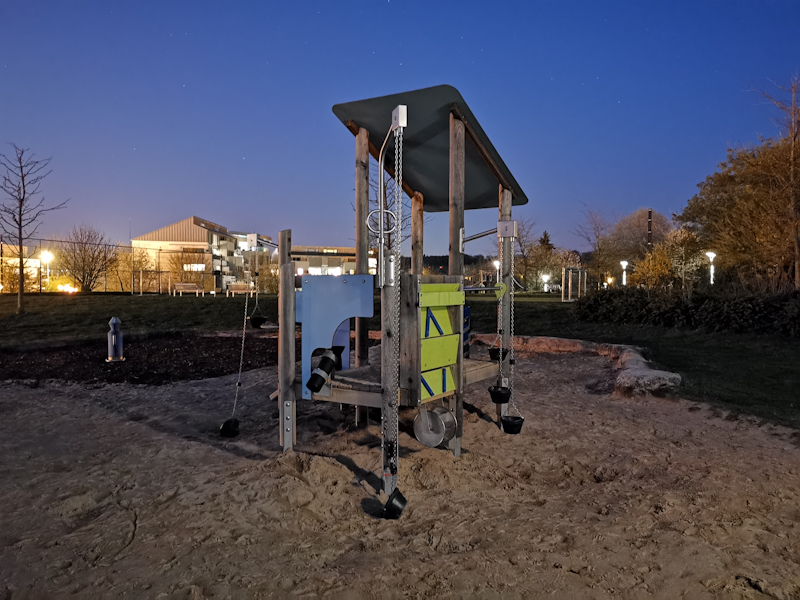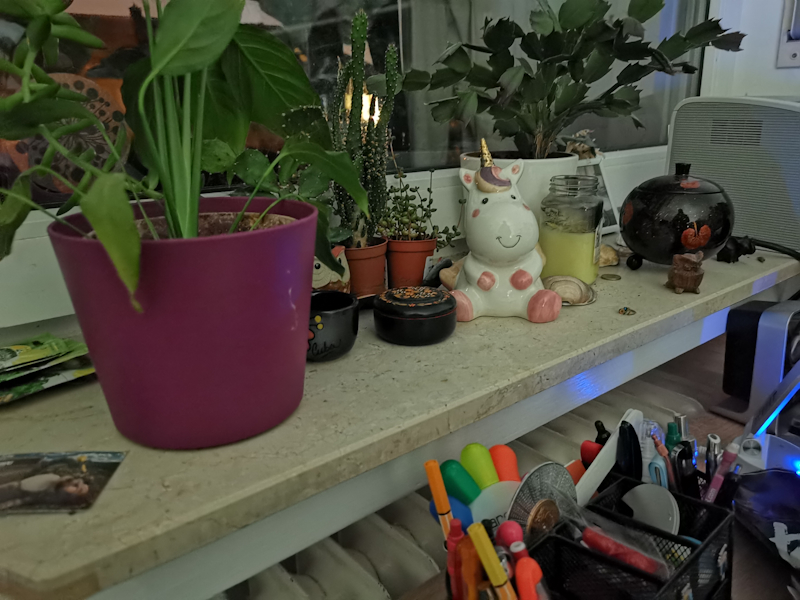The Huawei P30 & P30 Pro Reviews: Photography Enhanced
by Andrei Frumusanu on April 18, 2019 9:00 AM EST- Posted in
- Mobile
- Smartphones
- Huawei
- P30
- P30 Pro
Camera - Low Light Evaluation
Low-light photography is where Huawei’s strengths lie. Starting with the P20 the company was a pioneer in terms of computational photography, not only was the company able to improve low-light capture on smartphones with “regular” camera sensors, it also marked the start of customised camera sensor hardware that was able to achieve much higher ISO sensitivity than any other phone camera on the market.
Huawei’s rationale for adopting the RYYB sensor was in order to improve the low-light capabilities of the phone, promising 30% increased light capture. The P30 Pro in particular we’re expecting some massive low-light capture improvements, not only due to the new sensor but also thanks to the wider aperture as well as the integration of OIS in the sensor – something we haven’t seen in Huawei devices in several years.

[ P30 Pro ] - [ P30 ]
[ P20 Pro ] - [ P20 ] - [ Mate 20 Pro ]
[ S10+ (S) ] - [ S10+ (E) ] - [ S9+ (S) ]
[ G8 ] - [ G7 ] - [ V40 ]
[ View20 ] - [ OnePlus 6T ] - [ Pixel 3 ] - [ iPhone XS ]
As a note, shooting in 40MP mode in low light is pretty much a futile exercise, as the sensor just isn’t able to capture enough light without help of pixel binning down to 10MP.
Huawei had already a lead in low-light capture with its previous devices, and the only viable competition was the new Pixel’s Night Sight mode. With the P30s, Huawei now extends this lead. While not exactly reaching the level of detail on the Pixel 3’s Night Sight mode, the P30s both show very large improvements over their 40MP predecessors all while being leagues ahead of other traditional camera sensors.
It’s to be noted the Pixel 3’s Night mode was way off in terms of colour temperature, and the Huawei phones had a more correct representation of the orange illumination of sodium street lamps.
At certain brightness levels such as in this scene, Night mode on the Huawei phones can have a detrimental effect and results in blurred details, even though it produces a brighter image.
Both wide angle modules struggle in low-light, however Night mode can help out a lot. Again between the four wide angle shots between the P30 Pro and P30 we’re getting very different results, with the smaller P30 producing brighter results for some reason.

[ P30 Pro ] - [ P30 ]
[ P20 Pro ] - [ P20 ] - [ Mate 20 Pro ]
[ S10+ (S) ] - [ S10+ (E) ] - [ S9+ (S) ]
[ G8 ] - [ G7 ] - [ V40 ]
[ View20 ] - [ OnePlus 6T ] - [ Pixel 3 ] - [ iPhone XS ]
In this parking lot, again in regular shooting mode the P30s are ahead of the competition, with the only real contender being Google Night mode. Switching on the P30’s we see better exposure and shadows, although Google continues to retain a detail lead.
On the wide-angle camera, Huawei’s Night mode remains unchallenged. LG’s G8 comes near in terms of exposure, however it lacks details and is very noisy. Samsung’s new cameras are lagging far behind in this aspect.

[ P30 Pro ] - [ P30 ] - [ P20 Pro ] - [ P20 ]
[ Mate 20 Pro ] - [ S10+ (S) ] - [ S10+ (E) ] - [ S9+ (S) ]
[ G8 ] - [ G7 ] - [ V40 ] - [ View20 ]
[ OnePlus 6T ] - [ Pixel 3 ] - [ iPhone XS ]
This shot is quite challenging due to the high dynamic range between the illuminated truck cabins and the dark lower parts of the image. In the default mode, both P30s produced too dark images with not sufficient dynamic range, however on the P30 Pro the phone captures an evident HDR processed picture. I didn’t do anything special between takes, and this is something I’ve experienced in the past with Huawei devices. Unfortunately the phone has like a dozen capture modes which get triggered depending by scene, and one has little control over it and the result can only be determined by the resulting EXIF information in the image.
When in Night mode, the P30’s produce better shadows than the Pixel, however the latter continues to have an advantage in terms of detail. The Pixel is also a tad too saturated with the blue of the trucks, while the Huawei phones are too undersaturated.
Camera - Extreme Low-Light Evaluation
Moving on to extreme low-light conditions, these are scenarios we traditionally didn’t expect smartphones cameras to be effective at all. Most phones here will produce a dark image and are at their limit in terms of light capture. To be able to perform here, you need help of specialised sensors or sneaky computational photography.

[ P30 Pro ] - [ P30 ] - [ P20 Pro ] - [ P20 ]
[ Mate 20 Pro ] - [ S10+ (S) ] - [ S10+ (E) ] - [ S9+ (S) ]
[ G8 ] - [ G7 ] - [ V40 ] - [ View20 ]
[ OnePlus 6T ] - [ Pixel 3 ] - [ iPhone XS ]
In our playground shot in the night, the P30 Pro pulls in some incredible amount of light. The auto shot comes in at ISO25600, however due to the noise reduction you’re hard to notice any noise at all.
The smaller P30 had issues in terms of focusing correctly, and thus it resulted in a blurry shot.
Switching on Night mode, the P30 Pro is able to capture some outstanding results far ahead of any other device. The inclusion of OIS on the P30 Pro really augments the Night mode, and while in past devices we saw more blurred details in this mode, on the P30 Pro things actually get a lot sharper.
The Pixel 3’s Night mode can’t keep up here as even if it’s algorithmically superior, the sensor just isn’t able to capture enough input data.
Comparing the P30 Pro to say the iPhone XS really showcases the massive differences that we’re currently seeing in the competitive landscape, and the differences are absurd.

[ P30 Pro ] - [ P30 ] - [ P20 Pro ] - [ P20 ]
[ Mate 20 Pro ] - [ S10+ (S) ] - [ S10+ (E) ] - [ S9+ (S) ]
[ G8 ] - [ G7 ] - [ V40 ] - [ View20 ]
[ OnePlus 6T ] - [ Pixel 3 ] - [ iPhone XS ]
In this last in-door shot, the absurdity continues as the P30s are just in a different league. Again between the P30 Pro and the P30 we see the former take advantage of OIS and a resulting sharper picture.
Both phones in the auto mode area already ahead of the pack in terms of capture ability, but turning on the Night mode further widens the gap, achieving even more detail. I was actually aghast to see how natural the resulting image was, yet the actual room was much darker than what’s represented here.
P30 Pro & P30 Low-Light Evaluation Conclusion
Overall, Huawei here hit it out of the park in terms of low-light capture. The new sensors as well as the new optics on the P30 Pro really put the devices far ahead of the curve in terms of what they’re able to produce.
OIS for the P30 Pro in particular has notable benefits, especially when paired together with the Night mode. Huawei’s processing for Night mode is a lot brighter than previous devices. Google still seems to have the better algorithms and resulting Night Sight pictures can be a lot sharper and more detailed than Huawei’s Night mode, however under a certain threshold of low light even the Pixel 3 can’t keep up with Huawei’s new camera modules.
The P30 Pro is the best low-light camera smartphone on the market, with the P30 closely following behind. The competition really needs to scramble to improve their computational photography abilities, and be at least be able to match Google’s implementation. If we’ll see other vendors employ special sensors such as employed by Huawei is to be seen, but for now the company’s cameras are in a class of their own in low-light.










85 Comments
View All Comments
Quantumz0d - Thursday, April 18, 2019 - link
Good camera review, their auto mode looks good at night but the low light photography in smartphone arena is heavily faked. Be it Google insane algorithm for creating unnatural light or th damn Huawei night mode with HW. I think its too fake and perhaps they do have advantages in some situations but going from a dark room to a lit room is bad in my book.Next up the stupid curved glass copy they did from Samsung needs shaming. Plus its a waste that distortion of image is horrible and the damn construction is weak, see Jerry rig for it.
Then the worst parts - NanoSD ? WTF, please call them out for this, proprietary storages ? That's anti consumer, I use my SGS with 200GB SD card yes the 10Yr old phone with replaced battery and Fat32 works. And same in my iPods and V30S, and it works in PC without any stupid gimmicks or bloat.
Finally Andrei, I know your contribution to Samsung Exynos S9 disaster, it was only possible because it allows Bootloader unlock. That's the most powerful feature of Android and its principles of GNU GPL.
This Huawei junk is blocking access to that officially and in India I read the service centers demand DL for their Honor subsidiary, XDA portal people sold their soul to Huawei and OnePlus now their contract expired for OP and Huawei I guess. This is another massive hole in Huawei devices. I have every doubt about the firmware and SoCs from this CPC company I would really wish to have a Bootloader unlock for all their portfolio subsidiaries and themselves. Its bad, no ownership choice is horrible given how their EMUI blocks lot of stuff and notorious for its control over background processes.
You should include that in your reviews, please.
Thank you.
Quantumz0d - Thursday, April 18, 2019 - link
Also thank you for mentioning the 3.5mm jack and the stupid mono speaker in 2019. LG is Audio champion since a long time and hopefully they will retain that with their top class ESS Sabre implementation moving ahead. Also to note, LG and their new G8 has zero bumps which is a feat along with the Crystal Sound they call. Looking forward for piece.zeeBomb - Thursday, April 18, 2019 - link
You guys should take a look of MrWhoseTheBoss and his videos about this amazing phone. Such a shame you can't get it in carriers in the Americas, but man oh man.Ian Cutress - Thursday, April 18, 2019 - link
>You guys should take a look of MrWhoseTheBoss and his videos about this amazing phone.Any specific reason? You haven't exactly said why.
zeeBomb - Monday, May 6, 2019 - link
My bad. Sorry for the late reply too, he talks primarily about the sensor of the P30 Pro and its usefulness in Low Light. Just a suggestion to take a look.bogda - Thursday, April 18, 2019 - link
I think this statement: "...Huawei continues the senseless design choice of including a headphone jack on the smaller model while skipping it on the larger and more expensive P30 Pro.", makes much more sense if it is changed just a little bit into:"Huawei continues the senseless design choice of skipping a headphone jack on larger and more expensive P30 Pro while including it on the smaller model."
Awful - Thursday, April 18, 2019 - link
Great review but still missing half the picture when it comes to the camera. Time-of-flight sensor? Graduated blur based on depth map? Portrait/face lighting? People are the most photographed and most interesting subjects. Even if it's a mannequin with a wig for repeatability!s.yu - Friday, April 19, 2019 - link
Portrait lighting has been gimmicky for a few generations now. Regarding ToF, IIRC only the Nokia 9 has the proper implementation. Still there are pixel grade deviations and some people aren't satisfied. Personally if I were to add fake bokeh that precision would be enough for me.Awful - Saturday, April 20, 2019 - link
Yeah, they weren't really meant to be separate concerns- they're all factors contributing to portraits. I.e. how the exposure is chosen, how the depth is mapped to the bokeh/blue, how edge detection is done and masked for blurring, how AI/ML is used to make adjustments etc. All great computational photography stuff...that this review is silent on.Lau_Tech - Friday, April 19, 2019 - link
Hi Andrei, as a s10 exynos owner, was interested to see your updated comparison pics between the snapdragon and exynos. Looking at the pics from ur S10 review and now, it seems to me that the gap has closed substantially especially in daytime photos? What do you think?